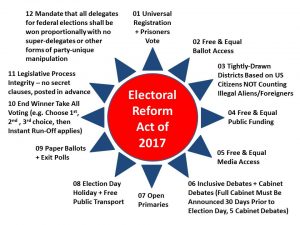 An investigative report from an Alert Reader.
An investigative report from an Alert Reader.
“noncitizens and illegal aliens are counted when apportioning congressional districts and when allocating state electors under the Electoral College. This means noncitizens play a role in determining how many congressional representatives a state has and exert an indirect influence on
See:http://www.fairus.org/issue/

Phi Beta Iota: It is said that California would have 4 less Electoral College Members, if their illegal immigrants were not counted. We have altered Provision 3 in the Electoral Reform Act of 2017 to correct this grotesque violation of citizen rights in apportioning districts.
See Also:
More from Alert Reader:
THE US CENSUS, ELECTORAL VOTES AND ILLEGAL IMMIGRATION
1.Introduction.
District, State, Congressional Representatives and Presidential Electoral
1. Distribution of Electoral Votes
“Electoral votes are allocated among the states based on the Census. Every state is allocated a number of votes equal to the number of senators and representatives in its U.S. Congressional delegation—two votes for its senators in the U.S. Senate plus a number of votes equal to the number of its members in the U. S. House of Representatives.
Under the 23rd Amendment of the Constitution, the District of Columbia is allocated three electors and treated like a state for purposes of the Electoral College.
The allocations below are based on the 2010 Census. They are effective for the 2012, 2016, and 2020 presidential elections.”
From: https://en.wikipedia.org/
“The members of the House of Representatives serve two-year terms representing the people of a
single constituency, known as a “district”. Congressional districts are apportioned to states by population using the United States Census results, provided that each state has at least one congressional representative. Each state, regardless of population or size, has two senators”
See:http://history.house.gov/
The Permanent Apportionment Act of 1929 capped the Membership at that level, creating a procedure for reapportioning state delegations in the House under “the then existing number of Representatives” (see Act of June 18, 1929, ch. 28, 46 Stat 21).”
“The U.S. Census Bureau provides more information on this method of computing apportionment.”
See:http://www.census.gov/
The Constitutional basis for conducting the decennial census is to reapportion the U.S. House of Representatives. Apportionment is the process of dividing the 435 memberships, or seats, in the U.S. House of Representatives among the 50 states.”
2. “Who's Counted
The apportionment calculation is based upon the total resident population (citizens and non-citizens of the 50 states. In the 2010 Census, the apportionment population also includes U.S. Armed Forces personnel and federal civilian employees stationed outside the United States (and their dependents living with them) that can be allocated back to a home state. These segments were also included in the apportionment population in the 1970, 1990, and 2000 censuses. The population of the District of Columbia is not included in the apportionment population.
3. How It's Calculated
The Constitution provides that each state will have a minimum of one member in the U.S. House of Representatives, and then the apportionment calculation divides the remaining 385 seats among the 50 states. Congress decides the method used to calculate the apportionment.
The method for calculating the apportionment has changed over time. The methods used through most of the 20th century have been based upon the use of a mathematically determined priority listing of states. Adopted by Congress in 1941 and used each census thereafter, the method of equal proportions also results in a listing of the states according to a priority value–calculated by dividing the population of each state by the geometric mean of its current and next seats–that assigns seats 51 through 435. The method of equal proportions is calculated according to provisions of Title 2, U.S. Code.
For a technical description of how the method of equal proportions was used in developing the apportionment counts, see Computing Apportionment.”
From: http://www.census.gov/topics/
What is the average population per representative based on the 2010 Census apportionment?
For the apportionment based on the 2010 Census population, the average population per representative is (COMING SOON).
Map: http://www.census.gov/
Are undocumented residents (aliens) in the 50 states included in the apportionment population counts?
Yes, all people (citizens and noncitizens) with a usual residence in the 50 states are to be included in the census and thus in the apportionment counts.
Are children under 18 years old included in the apportionment population counts since they cannot vote?
Yes, being registered to vote or voting is not a requirement for inclusion in the apportionment counts.
5. Congressional Apportionment: 2010
From: http://www.census.gov/
PDF Report:
“The Constitutional basis for conducting the decennial census of population is to reapportion the U.S. House of Representatives. Apportionment is the process of dividing the 435 memberships, or seats, in the U.S. House of Representatives among the 50 states. With the exception of the 1920 Census, an apportionment has been made by the Congress on the basis of each decennial census from 1790 to 2010.”
See also a full Report on this on the above link.
“The average size of a congressional district will rise. The number of representatives or seats in the U.S. House of Representatives has remained constant at 435 since 1911, except for a temporary increase to 437 at the time of admission of
Alaska and Hawaii as states in 1959 (see Table 1). However, the apportionment based on the 1960 Census, which took effect for the election in 1962, reverted to 435 seats. The average size of a congressional district based on the 2010 Census apportionment population will be 710,767, more than triple the average district size of 210,328 based on the 1910 Census apportionment, and 63,815 more than the average size based on Census 2000 (646,952). Based on the 2010 Census apportionment, the state with the largest average district size will be Montana (994,416), and the state with the smallest average district size will be Rhode Island (527,624).”
Note: It seems that because the number of Congressional Representatives stays the same, when the population grows in one area, seats will shift from one area to another:
“Twelve seats in the U.S. House of Representatives will shift from one state to another (page 4)
“Similar regional shifts occurred representation reflect regional after Census 2000. ” Table 3. Pg 5. Fig 2, Pg 5.
You will see that the percentage distribution has been increasing in the South and West and decreasing in the Northeast and Midwest.
CALCULATING APPORTIONMENT (Pg 6).
Congress decides the method final 385 seats that remain after the to calculate apportionment
Step 1: Automatically assign the first 50 seats.
Step 2: Calculate a list of priority values
A “priority value” is based on a state’s apportionment population and the number of its next potential seat. More specifically, the formula for a priority value (PV) equals the state’s apportionment population divided by the geometric mean of its current (n–1) and next (n) potential seat number.
pv(n)= State apportionment of population
s.root n x(n-1)
Step 3. Assigning the Remaining Seats in Rank Order
Comment: They average size of the a congressional district has changed:
The average size of a congressional district based on the 2010 Census apportionment population will be 710,767, more than triple the average district size of 210,328 based on the 1910 Census apportionment, and 63,815 more than the average size based on Census 2000 (646,952). Based on the 2010 Census apportionment, the state with the largest average district size will be Montana (994,416), and the state with the smallest average district size will be Rhode Island (527,624)
The report does not say or make it clear whether the Calculation Apportionment Method makes for a fair and equitable allocation of Congressional Representatives
Whichever way ones looks at it, it still doesn’t change the fact that illegal immigrants are included in the Census and consequently are included in, and influence, the US electoral process.
Conclusion
The established practice of including illegal Immigrants in the US Census has a consequential affect on the outcome of the US Electoral process at both the District, State, Congressional and Presidential Levels as these are based on Census numbers. The Calculation
Footnote:
“California has the largest number of illegal immigrants in the United States, with an estimated 2.4 million unauthorized immigrants making up about 6.3 percent of the state’s total population, according to the Pew Research Center.
In 2012, while California had more numbers than any other state, the highest percentage of the overall population went to Nevada, where unauthorized immigrants accounted for 7.6 percent of the state’s population.
The Migration Policy Institute estimated the number of illegal immigrants living in California to be much higher than the Pew Research Center's estimate. The Migration Policy Institute estimated a little more than 3 million undocumented residents living in the state.”
See: http://www.newsmax.com/
SPECULATIVE CONCLUSION: The fact that illegal aliens are counting when allocating Congressional districts would appear to be a very tangible incentive for states such as California to NOT enforce the law and welcome illegal aliens precisely because they augment the state's political power at the federal level.



